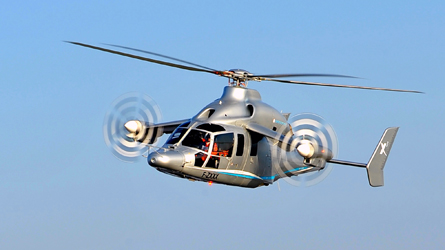EADS has showed off its X3 compound helicopter concept to potential US civilian and military customers near Washington, DC.
Company test pilots demonstrated the high speed capabilities of the machine in a spectacular aerial display in Manassas, Virginia, a short distance away from the capital. Where conventional helicopters approach the absolute limits of their performance at about 180kt (333km/h) airspeed due to the dissymmetry of lift on the rotor disk, the X3 is designed to push the performance envelope well into the 200kt+ flight regime. The only other helicopter designed to operate at such high speeds is Sikorsky’s X-2 concept demonstrator.
Though the X3 aircraft has achieved speeds of 232kt during test flights, for the demonstration, test pilot Herve Jammayrac says he achieved speeds between 190-200kt. But, powered by two 2,300shp turboshaft engines, the aircraft is likely to be able to fly faster still: already it has hit speeds of 242kt in a descent.
 |
|---|
EADS |
The aircraft is able to delay the onset of retreating blade stall — a component of dissymmetry of lift — by generating 40% of the lift needed to keep the aircraft airborne from a small pair of wings during forward flight, says Eurocopter flight test engineer Dominique Fournier. The aircraft has no anti-torque rotor, instead that function is provided by deferential blade angles of two propellers which provide forward thrust, he says. Fournier adds that the basic X3 design can be scaled up in size from the 6t range to the 14t or greater range.
"I think it will be a game changer," says Marc Paganini, chief executive of American Eurocopter, a division of EADS. He adds that the aircraft represents "the future of the aviation industry".
One of Eurocopter’s goals in the Washington DC region is to entice the US Department of Defense to invest in the X3 technology. The ultimate goal is to secure a place in the US Army’s future vertical lift (FVL) programme, says retired US Army Maj Gen Stephen Mundt, vice-president of business development at EADS North America. "Bottom-line is we’re very, very interested in future vertical lift," he says.
Mundt says he expects the DoD to have completed its initial "paperwork" by December, after which it will release a broad agency announcement spelling out the FVL’s overall performance goals. The services will then down-select a design that will fly in 2017.
"Do I believe that this has the opportunity to compete in terms of the joint multi-role/future vertical lift where we’re going to try replace 4,500 aircraft in the Department of Defense?" Mundt asks. "I believe this can do that. So yes, I see a bright future inside the military."
If the X3 is selected for the DoD/US Army FVL contract, development work would be undertaken inside the USA, Paganini says. "We will have to develop it — the concept has been developed in Europe — if the concept is acceptable, is interesting for the US Army, and they decide to give us a contract to continue developing it, it will be developed in the US, of course, for simple ITAR [International Traffic in Arms Regulations] regulation."
Source: Flight International




















